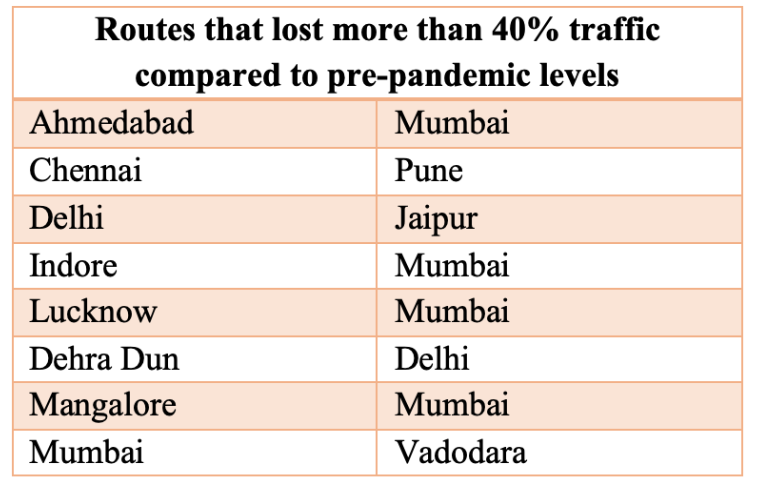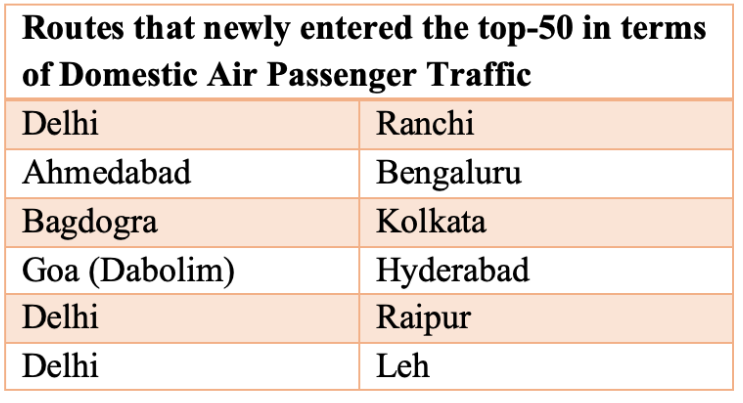While aviation was one of the most affected sectors because of the COVID-19, a detailed analysis of the city-pair traffic data from the DGCA indicates that many routes connecting Mumbai have witnessed a significant drop in passenger traffic. The same has not been the case with routes connecting Delhi.
Factly had earlier analysed the trends in domestic air passenger traffic pre- and post-pandemic. Data revealed that there has been an improvement in numbers in 2021 and 2022 following the pandemic, compared to 2020. However, the Domestic Air Passenger traffic is still significantly lower than in 2019. India’s aviation sector had handled more than 10 crore passengers each year prior to the pandemic which has now dropped to 6.3 crores in 2020, and 8.38 crores in 2021, indicating a slow recovery.
In this story, we look at the trend in domestic passenger traffic across the top-50 routes with the most domestic passenger traffic between 2016 and 2021 using the Director-General of Civil Aviation (DGCA)’s monthly domestic city pair-wise data. That is, it provides data on the number of passengers commuting to and from a pair of cities, say city 1 and city 2. For the analysis in this story, the total number of passengers commuting between city 1 and city 2 in a specific calendar year has been calculated by adding the total number of passengers commuting to and from the two cities through the 12 months of that year.
Share of top-10, top-20, and top-50 routes to the total air domestic passenger traffic has declined over the years
The share of top-10, top-20, and top-50 routes to the total air domestic passenger traffic has declined over the years. A possible reason for this could be the increase in the number of routes being operated. As per the DGCA’s domestic city pair-wise data, the number of routes has gone up from 314 as of 2015 to 567 in 2021 (as of December of the respective years), an increase of 80%.
The share of the top 10 routes has dropped by 9.2 percentage points in six years from 30.3% in 2016 to 21.2% in 2021. There has been a marginal improvement in the share of the top ten routes in 2021 as compared to 2020.
Contributing to nearly 46% in 2016, the share of passenger traffic in the top-20 routes has dropped by over 12.7 percentage points to 33.1% in 2021. During this period, the share of the top-50 routes has dropped by 14.35 percentage points. The share of these routes was more than two-thirds of the total domestic air passenger traffic in 2016 which has dropped to 55% in 2021.
Passenger traffic from Major cities was used for the analysis
Among the top-50 routes for each year between 2016 and 2021, the percentage share of the domestic air passenger traffic along those routes connecting at least one of the major cities- Delhi, Mumbai, Hyderabad, Bengaluru, Kolkata, and Chennai has been calculated. The passenger traffic, say, between Delhi and Mumbai has been counted under both Delhi and Mumbai’s share of the total traffic of the top-50 routes. In other words, the share of traffic from or to these cities is those passengers who have either boarded or alighted in that particular city.
For instance, to calculate the passenger traffic contributed by Delhi in the top-50 routes, we have taken into consideration the traffic across all those routes connecting Delhi and another city in the top-50 of each year. In each of 2016, 2017, and 2020, there were 22 routes that connected Delhi and another city in the top-50 while in 2018 and 2019, there were 21 such routes. In 2022, 23 routes connected Delhi in the top-50.
Share of passenger traffic connecting Delhi contributes to more than half the traffic in top-50 routes
The share of passenger traffic connecting across routes connecting Delhi to the total passenger traffic in the top-50 routes has always been above 50%. Unlike the trend across other major cities like Mumbai and Bengaluru, the share of traffic contributed by routes connecting Delhi has been on a rise- from 51.1% in 2018 to almost 57% in 2021. Though the contribution of top-50 routes is on a decline, the share of passenger traffic in routes connecting Delhi is increasing, implying that routes connecting Delhi are the most used.
At the same time, the share of passenger traffic across routes connecting Mumbai in the top-50 routes has been on a gradual decline. The share was more than 38% in 2016 which has come down to about 25.5% in 2021. In each of the last six years, there were 11 to 12 routes connecting Mumbai in the top-50 list.
Meanwhile, share in the top-50 routes of both Bengaluru and Kolkata increased between 2016 and 2020 and dropped in 2021 while Hyderabad overtook Chennai in terms of percentage contribution to domestic air passenger traffic in the top-50 routes.
Passenger traffic in the Delhi – Mumbai route has been the highest, followed by Bengaluru – Delhi
Throughout the six-year period from 2016 to 2021, the domestic air passenger traffic in the Delhi – Mumbai route has been the greatest, followed by the Bengaluru – Delhi route. Passenger traffic in the Delhi – Kolkata route has been the fourth highest in this period. The three routes alone contributed to 19% of all the traffic in the top-50 routes in 2016 which has declined to 15% in 2020 and 2021, higher than that contributed by the routes connecting other major cities like Chennai and Hyderabad.
Traffic in Ahmedabad – Mumbai route dropped to 40% following pandemic
Eight (8) routes that were among the top-50 back in 2016, cease to be a part of the list now. Among these 8 routes, 5 are those which connect Mumbai. Mangalore – Mumbai and Mumbai – Vadodara witnessed an increase in passenger traffic in 2017 and the number has dropped since then. Ahmedabad – Mumbai route had more than 20 lakh passengers each between 2016 and 2019, however, in 2020 and 2021, following the pandemic outbreak, the traffic on this route along with that in Chennai – Pune, has dropped drastically to less than 40% of the pre-pandemic levels. The following routes witnessed a drop of more than 40% in the annual traffic compared to pre-pandemic levels.

Delhi-Leh reported its highest passenger traffic in 2021
Some routes that have newly entered the top-50 are listed below. The passenger traffic in Delhi – Ranchi, Ahmedabad – Bengaluru, Bagdogra – Kolkata, Goa – Hyderabad, Delhi – Raipur, and Mumbai- Varanasi in 2021 is more than that of 2016 levels. The passenger traffic in Delhi-Leh has increased by more than 3 times in 2021 compared to 2020 to reach the highest traffic on that route to date. Delhi-Leh is now among the top-50 routes. Among the 16 routes that newly entered the top-50 since 2016, 5 involved Delhi and 3 involved Bengaluru.

The growth of passenger traffic in older routes is lower than that in newer routes
The passenger traffic in the Kochi – Mumbai route which was quite popular with an annual average of 12 lakh passengers before the pandemic, has dropped to less than 40% post-pandemic whereas Delhi – Jammu & Chandigarh – Delhi, and Chandigarh – Mumbai, which was among the top-50 in 2016 and 2017 witnessed a decline in passenger traffic in 2018. However, in 2021, Delhi – Jammu recorded the highest traffic since 2016 while Chandigarh – Mumbai recorded the highest traffic since 2018.
Routes such as Bengaluru – Mumbai, Chennai – Delhi, Chennai – Mumbai, Delhi – Pune, Hyderabad – Mumbai, Kolkata – Mumbai, Bengaluru – Pune, Jaipur – Mumbai, Chennai – Kolkata, Guwahati – Kolkata, Delhi – Varanasi, and Delhi – Kochi, despite having witnessed an increase in passenger traffic before the pandemic, have dropped in their position in the top-50.
This implies that the growth in traffic in these routes is lower than that in other routes such as Delhi – Hyderabad, Delhi – Srinagar, Delhi – Patna, Delhi – Guwahati, Bagdogra – Delhi, Delhi – Ranchi, Delhi – Goa, Bengaluru – Kolkata, and Hyderabad – Kolkata which has witnessed a significant improvement in their position in the top-50. Hyderabad – Kolkata entered top-50 only in 2016 and has gone up from 45th position to 20th in the span of 6 years.
COVID-19 restrictions, infrastructure, and tourism could be some of the factors influencing this trend
Multiple factors may have influenced these trends. For instance, the caseloads and restrictions imposed due to COVID-19 influence the traffic across cities. For instance, in Mumbai, the passenger traffic could have been severely affected as the state had the highest caseload and some of the most stringent restrictions during the pandemic. Another factor that could have influenced these trends is tourism revival post the pandemic where people may have wanted to go around after being confined to homes for a long period. An example of this could be the increase in the share of passenger traffic on routes connecting Goa.
In the case of Mumbai, there have been reports of the airport facing heavy congestion even in 2018. Reports also indicate that airlines are setting up their bases in Delhi and Bengaluru airports. With the increasing number of low-cost carriers (LCCs) that need airports where things move fast to minimize time & resources, the Mumbai airport might be losing out and in turn, routes connecting Mumbai may be losing passengers.
Featured Image: Domestic Air Passenger Traffic drop post-pandemic


